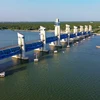Hanoi (VNA) – The World Bank released a report analysing natural disasters in Vietnam’s coastal areas and assessing the country’s risk management on October 21.
The “Resilient Shores” report, jointly developed by the Government of Vietnam, the World Bank, and the Global Facility for Disaster Reduction and Recovery, said that Vietnam’s coastline is increasingly exposed to natural disasters, resulting in significant human and economic losses, but current risk management measures prove inadequate.
“A new resilience development strategy is urgently needed, otherwise, additional economic growth over the next decade in the range of billions of dollars could be wiped away by natural shocks,” it stressed.
“If the current trends of rapid economic development in high-risk areas continue, disaster losses are bound to increase,” said Carolyn Turk, World Bank Country Director for Vietnam. “It’s time for a new approach to balance the risks and opportunities so that Vietnam’s coastal regions can continue to be an engine of growth while being resilient to shocks”.
The ongoing devastating storms and floods that battered the central part of Vietnam are the latest evidence of a worrying trend that natural risks, which have already been substantial, are intensifying due to rapid urbanization, economic development, and climate change.
Tran Quang Hoai, Director General of the Vietnam Disaster Management Authority under the Ministry of Agriculture and Rural Development said: “To ensure the sustainable development of Vietnam’s coastal zones, we cannot ignore the challenges of natural shocks and climate change. To secure prosperity, we must invest in resilience”.
The report estimates that 12 million people in coastal provinces are exposed to the threat of intense flooding and over 35 percent of settlements are located on eroding coastlines. Each year, an average of 852 million USD – or 0.5 percent of GDP – and 316,000 jobs in key economic sectors are at risk from riverine and coastal flooding.
Public facilities and infrastructure are also at risk, which means disruption of service delivery at the time when they are most needed. Severe flooding affects directly 26 percent of public hospitals and healthcare centres and 11 percent of schools in the region. More than one-third of Vietnam’s power grid is located in forested areas, at risk of being damaged by storm-induced fallen trees, according to the report.
The report presents a concrete action plan in five strategic areas that needs to be rolled out immediately and decisively, including strengthening data and decision-making tools by establishing openly accessible natural disaster databases, as well as asset management systems for critical infrastructure; factoring risks in zoning and spatial planning based on the best available information, strengthening the resilience of infrastructure systems and public services by upgrading such assets in the most exposed and under-protected areas and updating existing safety standards; taking advantage of nature-based solutions by tapping into the protective function and economic contribution of ecosystems in a systematic manner, and improving disaster preparedness and response capacity by upgrading the early warning system, strengthening local response capacity, improving social safety nets and implementing comprehensive risk financing./.
VNA
























